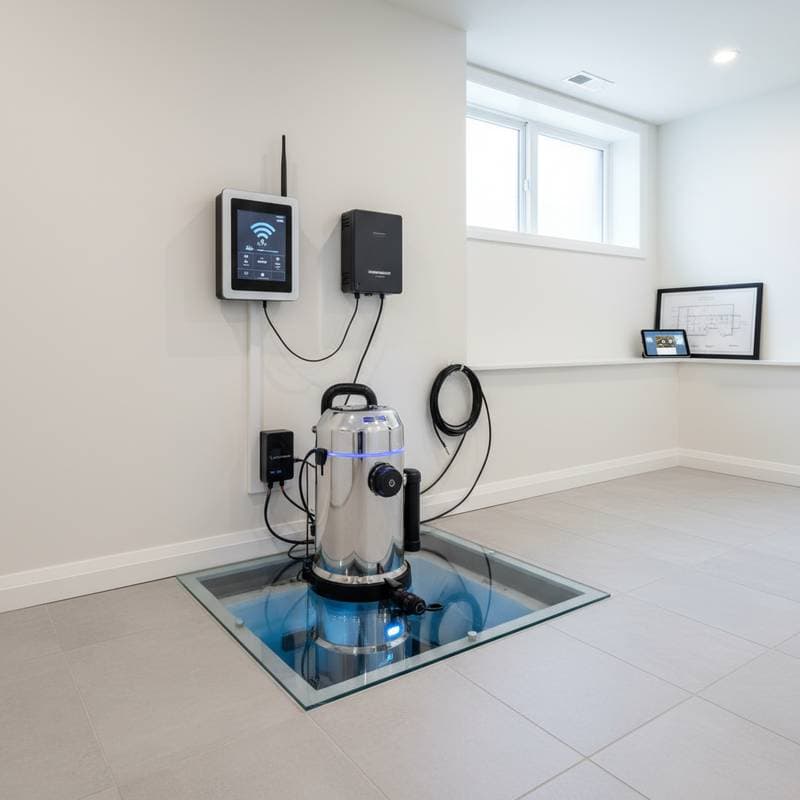Understanding Smart Sump Pumps
Smart sump pumps represent an evolution in home waterproofing technology. These devices automatically detect rising water levels in the sump pit and activate to pump water away from the foundation. Unlike traditional models, smart versions connect to home Wi-Fi networks, sending instant alerts to your smartphone if issues arise, such as power failures or blockages.
Key features include float switches or ultrasonic sensors for precise water detection, variable-speed motors for efficient operation, and integration with smart home ecosystems like Alexa or Google Home. Many models also incorporate dual-pump setups, where a secondary pump takes over during high-volume events. This setup ensures continuous protection during prolonged storms or heavy rainfall.
Installation typically involves placing the pump in an existing or newly dug sump pit, connecting it to a discharge pipe that leads water at least 10 feet from the house, and wiring it to power with a backup battery. Professional assessment of your home's drainage and soil type is essential to select the right capacity, often measured in gallons per hour.
Cost Breakdown for Smart Sump Pump Systems
The price of a smart sump pump system varies based on components and installation needs. Basic units start at $200 to $500, while advanced models with Wi-Fi, alarms, and backups range from $600 to $1,500. Battery backups add $150 to $300, and dual-pump configurations can increase costs by $400 or more.
Professional labor costs $300 to $1,200, depending on the region and project complexity. A complete system installation thus ranges from $1,200 to $3,500. Homeowners with an existing pit and discharge line may retrofit smart features for under $1,000.
In regions with elevated groundwater or regular storms, investing in premium options proves valuable. Dual pumps, sophisticated alarms, and sturdy batteries prevent potential $10,000 flood cleanup expenses. Local factors, such as soil permeability and proximity to water tables, influence the ideal system size and cost.
Optimal Timing for Installation and Market Considerations
Spring and early fall serve as prime periods for sump pump installation or upgrades. Contractors complete work efficiently before intense rain seasons arrive. The market for smart sump pumps remains steady, though prices exceed those of basic models due to electronics and software.
Supply chain issues sometimes delay certain brands, so advance ordering helps. Battery backups and control units deplete quickly in stormy seasons. One homeowner faced a multi-week wait after attempting a mid-season upgrade.
Planning ahead of rainy periods allows negotiation of favorable rates and avoids rush surcharges. This strategy often saves hundreds of dollars for typical installations.
Calculating Return on Investment and Property Value Effects
Smart sump pumps deliver strong financial returns in waterproofing investments. They avert substantial water damage while boosting buyer trust during home sales. Real estate professionals often emphasize dry basements as key attractions.
Value components include:
- Damage Avoidance: Prevents $8,000 to $15,000 in losses to flooring, walls, and furnishings.
- Insurance Perks: Certain providers reduce premiums for systems with monitoring capabilities.
- Power Savings: Sensors activate pumps only as required, cutting electricity by 10 to 20 percent over legacy units.
- Selling Boost: Proven waterproofing enhances property value by 3 to 5 percent.
Investments recover quickly, particularly in vulnerable areas. Maintaining dry spaces preserves usability and long-term worth.
Essential Maintenance and Troubleshooting Guidance
Smart sump pumps demand minimal oversight yet thrive with regular upkeep. Establish quarterly reminders for these tasks:
- Inspect the pit by removing the cover and clearing debris or sediment.
- Test discharge by adding water to verify pump activation and proper drainage.
- Examine the battery and replace it every two to three years, or promptly upon system alerts.
- Clean sensors lightly to avoid inaccurate detections.
- Update firmware and app versions for optimal security and efficiency.
Persistent motor sounds, frequent cycling, or activation lags warrant professional service. Numerous systems support remote troubleshooting via manufacturer or contractor apps, streamlining resolutions.
Steps to Secure Your Basement Today
Begin by evaluating your current setup through a professional inspection. Select a system matching your home's water risks and integrate it with existing drainage. Regular monitoring via the app ensures proactive responses to threats.
These measures transform potential disasters into managed routines, safeguarding your investment and lifestyle.


